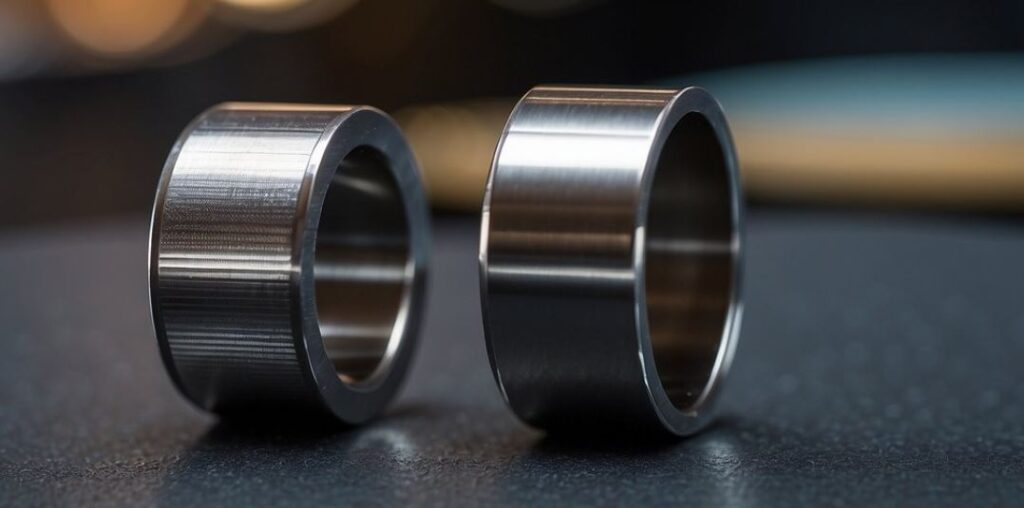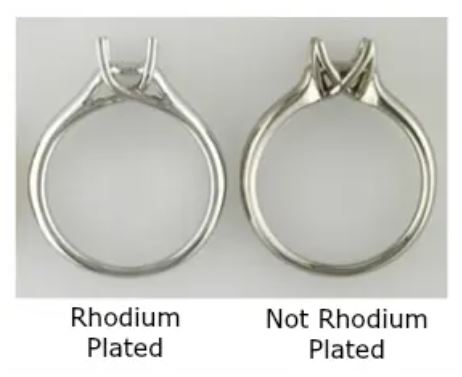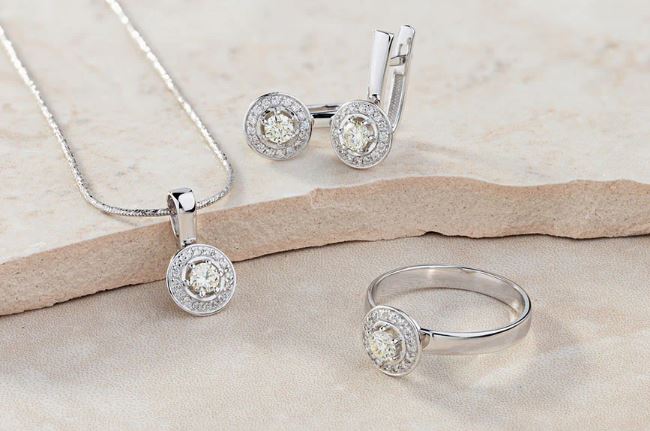Stainless Steel vs White Gold
Stainless steel has a better tarnishing and scratch resistance compared to white gold. It is more durable and low cost option for ones who don’t want to spend more money. White gold has better appearance and premium looks compared to stainless steel. White gold has more customization and variety of designs as many jewelers deal with white gold. Stainless steel lacks customization options.
In this article we’ll define white gold and stainless steel difference, draw a full comparison of stainless steel vs white gold and explain which metal is better for your buying preferences.
Stainless Steel
Stainless steel is a widely used metal in jewelry due to its exceptional durability and corrosion resistance properties. Stainless steel is composed of iron and carbon with a thick coating of chromium over. This chromium coating not only gives it a lustrous white look but also saves it from damages like scrtaches, dents and bumps. It is one of the best metal you can buy for daily wear jewelry for its tough and low cost features.
Composition and Types of Stainless Steel
Stainless steel contains at least 10.5% chromium, which gives it its corrosion resistant properties. In jewelry, the most common types of stainless steel are:
306 Stainless Steel: A non-hypoallergenic type of stainless steel and should be avoided at all costs in jewelry.
304 Stainless Steel: Known for its general resistance to rust and corrosion.
316L Stainless Steel: Surgical grade steel that’s highly resistant to corrosion and hypoallergenic, making it ideal for body jewelry and sensitive skin.
Properties of Stainless Steel
Following are the properties of stainless steel to understand you better the comparison of white gold vs stainless steel.
1. Durability
Durability is the property of a metal to resist damages like scratches and dents. One of the stainless steel’s most appealing characteristics is its durability. It’s an amazingly hard material that is highly resistant to scratches and dents. Compared to white gold, it is way ahead.

2. Non-Tarnishing
It doesn’t tarnish or oxidize over time, meaning it can retain its polished appearance for years with minimal maintenance. Stainless steel is also resistant to rust and corrosion, making it an ideal material for jewelry that will be exposed to water, chemicals, or sweat.
3. Hypoallergenic
Another key feature of stainless steel is its hypoallergenic nature. It is the property of a metal to not react with skin and cause allergies. While stainless steel does contain nickel, high quality surgical grade stainless steel (like 316L) is designed to be safe for most people with sensitive skin. This makes it a popular choice for those who want affordable jewelry without the risk of allergic reactions.
Uses in Jewelry
Stainless steel has become increasingly popular in the jewelry world, particularly for men accessories like rings, watches, and bracelets. It’s also used in necklaces, earrings, and cufflinks due to its sleek, industrial look. The metal’s resistance to tarnishing and corrosion makes it ideal for everyday wear, especially for active individuals or those who frequently expose their jewelry to water and sweat.
How does Rhodium vs Stainless Steel go on?
Rhodium is a premium white color metal mostly used in rhodium plating. However, rhodium plated stainless steel is not going to make any difference. Stainless steel is already pretty white and lustrous.
White Gold
White gold is an alloy made by mixing pure gold with other metals like palladium, silver, or nickel to create a stronger, more durable material. Pure gold is too soft for practical use in most jewelry, so alloying it with other metals increases its strength and hardness while giving it a white, silvery hue.
Composition and Varieties of White Gold
White gold comes in various karat levels, which refer to the amount of pure gold in the alloy:
18K White Gold: Contains 75% gold with best for people who want premium looks.
14K White Gold: Contains 58.5% gold and is more durable due to the higher proportion of alloyed metals. Best combination of premium looks and durability.
9K or 10K White Gold: Contains far less gold than earlier ones. Ideal for ones who want gold alike looks at a low cost. However, it can tarnish and can also be non-hypoallergenic.
Properties of White Gold
White gold has a lustrous, elegant appearance, making it a popular choice for fine jewelry, particularly engagement rings and wedding bands. However, white gold is not naturally white. The whitish hue is achieved by plating the gold with rhodium, a metal from the platinum family. White gold is softer than stainless steel, which means it’s more susceptible to scratches and dents. However, it’s much more valuable due to the gold content, making it a prized material in the world of fine jewelry.

Uses in Jewelry
White gold is widely used in luxury items like engagement rings, wedding bands, necklaces, and high end watches. It’s a classic choice for those who want the timeless beauty of gold but with a more contemporary, silvery hue. Because of its association with wealth and luxury, white gold is often used in heirloom pieces and items meant to last a lifetime.
Stainless Steel vs White Gold – A Short Comparison
Here is a short comparison of stainless steel vs white gold discussing a short comparison.
1. Durability and Longevity
Stainless steel is more durable than white gold is resistance against scratches and other damages. White gold on the other side is softer, more prone to scratches and can be damaged hard.
2. Scratch Resistance
Stainless Steel is highly scratch resistant, making it a favorite for people who want jewelry that can endure rough handling or everyday wear. While durable, white gold is softer due to its gold content, particularly in higher karat alloys. It is more prone to scratches, which may require polishing and care over time.
3. Corrosion and Tarnish Resistance
Stainless Steel is a one of the most corrosion resistant metals and will not tarnish or rust even when exposed to moisture, chemicals, or extreme environments. This makes it ideal for active individuals or those living in humid climates. While white gold’s resistance to tarnish is largely dependent on its rhodium plating or platinum addition. As the rhodium wears off, the underlying metal may begin to show, and the jewelry might require re-plating to maintain its appearance.
Or if nickel is added instead of platinum, it is going to tarnish way faster.
4. Luxury
Stainless steel is often considered a cheap metal to have. Most people might only like to wear it for their daily use but now for events or gatherings as it is easily identifiable. No one uses it for special occasions or events.
White gold on the other hand can provide the premium gold feeling and texture one is looking for. After all, gold is gold.

5. Maintenance
Stainless Steel virtually maintenance free, stainless steel doesn’t require special care or polishing to retain its appearance. A simple cleaning with mild soap and water is usually sufficient. On the other hand White gold requires more upkeep, especially due to the rhodium plating. Over time, the plating can wear off and may need to be reapplied to keep the jewelry looking fresh and vibrant.
6. Price Comparison
One of the most significant differences between stainless steel and white gold is the price. Stainless steel is a relatively inexpensive material, making it a popular choice for budget conscious consumers. It offers excellent durability and aesthetic appeal at a fraction of the cost of white gold.
White gold, on the other hand, is much more expensive due to the gold content. The price of white gold fluctuates based on the current market value of gold, as well as the karat rating. Higher karat white gold is more expensive but also softer and less durable. The rhodium plating, which gives white gold its bright white finish, also adds to the cost. Apart from this, white gold has a higher density which will result in more metal usage than stainless steel for the same jewelry item.
For those on a budget, stainless steel is an excellent option that offers durability and style without the hefty price tag. White gold, while more expensive, is a luxurious choice that appeals to those who want the timeless beauty of gold in a more modern, silvery hue.
Which One Should You Choose?
When deciding between stainless steel and white gold, it ultimately comes down to personal preference and priorities. If you’re looking for an affordable, low maintenance option that’s durable and hypoallergenic, stainless steel is a fantastic choice. It’s perfect for everyday wear, particularly for active individuals or those on a budget.
On the other hand, White gold is a luxurious material that appeals to those who want the elegance and prestige of gold in a more modern, white finish. While it requires more maintenance and comes with a higher price tag, white gold is a timeless choice for fine jewelry and special occasions.
Conclusion
Both stainless steel and white gold have their unique advantages and disadvantages. Stainless steel is a practical, budget friendly option that offers durability and style with minimal maintenance. White gold, while more expensive and delicate, is a luxurious material that exudes elegance and sophistication. It is up to the customer to decide what they properties they want their metal to have and on what they can compromise.

